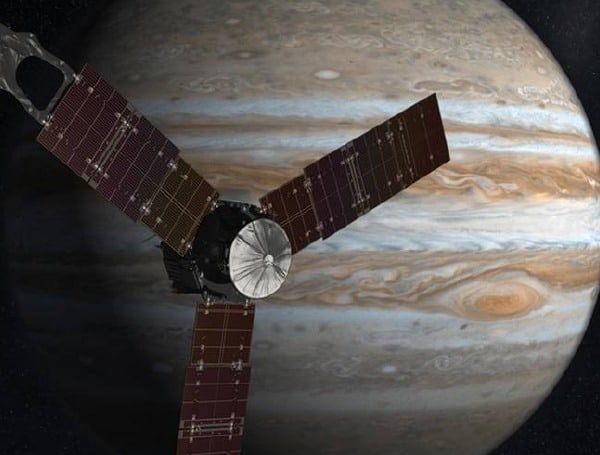On June 7th, NASA’s Juno spacecraft will make a close approach to the gas giant’s huge moon, flying within 645 miles of Ganymede. Launched August 5th, 2011, the spacecraft was the second spacecraft in the New Frontiers program and was sent to Jupiter to find out how much water is in its atmosphere along with other atmospheric readings such as composition, temperature, and cloud motions.
Additionally, it mapped Jupiter’s magnetosphere to reveal the planet’s structure and studied the planet’s poles, with a particular focus on its auroras and how the magnetic force affects Jupiter’s atmosphere.
While the primary focus of Juno was originally solely Jupiter, its mission was extended to focus on its moons and the rest of the Jovian system. First stop is Ganymede, where Juno will use its onboard instruments to study the moon’s composition, ionosphere, magnetosphere, and its thick shell of ice. It will also study the radiation near the moon to help prepare future missions to the Jovian system.
On its approach, Juno will point its Ultraviolet Spectrograph (UVS), Jovian Infrared Auroral Mapper (JIRAM), and its Microwave Radiometer (MWR) towards the moon to inspect the ice shell’s depth and composition, helping us to better understand how it was formed and how it continues to resurface the ice over time. It will also use its radio wavelengths on the X-band and Ka-band to perform an experiment to test the ionosphere.
As the spacecraft rounds behind Ganymede, these radio signals will pass through the moon and cause small changes in the frequency being sent back to the antennas on Earth. Measuring the change could help determine the connection between the ionosphere and Jupiter’s magnetosphere.
A smart repurpose of the nav systems in the Stellar Reference Unit (SRU) will be used to gather info from the radiation environment near Ganymede by using a special process to image the reactions. As they take imagery, radiation-noise will show up as dots, squiggles, and streaks, and can help determine the radiation levels from these signatures. Also, the Advanced Stellar Compass camera will count electrons penetrating the shields, testing it every quarter of a second.
Not only looking to study the radiation and magnetic properties of the Jovial moon, the JunoCam will be taking images of the surface and will allow researchers to compare to previous missions, both Voyager and Galileo, to look for differences. A lot of things can happen structurally over the course of over four decades, and craters help astronomers determine how many objects are impacting moons way out in the outer solar system.
If you think that sounds like a lot, it is, but there is only a short period of time to do it. Juno is going to be passing by Ganymede at 12 miles per second, so every single precious moment counts.
Beyond that, Juno will be visiting Europa in September of 2022, and finally, fly past Iow in both December of 2023 and February in 2024 before it makes a couple more orbits and intentionally deorbits and burns up in Jupiter’s atmosphere in 2025.
With such a successful mission so far, it’ll be exciting to see what pictures and results the spacecraft continues to deliver in its final orbits, and how they portray the beautiful gas giant and its array of fantastically unique moons.
Support journalism by clicking here to our gofundme or sign up for our free newsletter by clicking here
Android Users, Click Here To Download The Free Press App And Never Miss A Story. It’s Free And Coming To Apple Users Soon.
